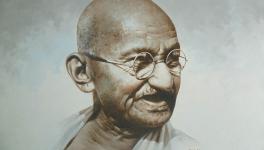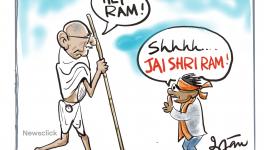How Hindutva Terror Outfits Hide in Plain Sight
‘When Crimes shoot up, they become invisible.
When pain becomes unbearable, cries are no longer heard.’
—Bertolt Brecht
Can the provocations of a cabinet minister, who openly raises controversial slogans, be considered a “breach of peace” or are they merely attempts to “gauge people’s mood”, as the minister would have us believe? For more than a month, plenty of controversial slogans have been raised on the streets of India. People are being instigated to “kill the traitors to the country” by members of the ruling dispensation, who are issuing open threats in public as the masses are getting angrier against the CAA, NRC and the NPR.
As expected, till date, either no action has been taken by the law and order machinery or there is only an expectation of perfunctory action. This new normal is symptomatic of the rapid erosion of the rule of law in the country. A new normal wherein the chief minister of a state has no qualms in talking of taking “revenge” against protesters while his state’s police unleash unjustified violence on protesters and bystanders alike. Each of their tactics has, for this reason, received widespread condemnation. Even though the strong-arm tactics of the state are failing to pass the test of logic or reasonableness, there is still no change in the ruling dispensation’s attitude.
Remember, it is more than three weeks since right-wing storm-troopers attacked a premier educational institution and wounded many. The chief minister of Maharashtra compared that attack to the “26/11 Mumbai terror attack”. Sure, a hyperbolic comparison, but there is enough proof available through WhatsApp groups, CCTV footage, etc, and yet neither the participants nor the masterminds of the attack have been apprehended yet. This is enough indication of what lies in store.
The situation is further complicated by the fact that the media, which is supposed to be the watchdog of democracy, has largely turned into a cheerleader of the establishment.
In such an ambience, where vigilantism is being increasingly promoted, sanctioned and normalised, the arrest of Pratap Hajra, an alleged bomb-making expert, and one who has allegedly trained scores of people to use firearms and make improvised explosive devices (IEDs), has largely gone unnoticed. Pratap, leader of ‘Bhavani Sena’, was also allegedly involved in carrying out bomb attacks at the Sunburn Music Festival in Pune in 2017. He was recently arrested by the Kolkata police and handed over to the Maharashtra police.
A perusal of old newspaper reports reveals that Hajra had come under the police/intelligence scanner after the Nalasopara arms haul case in 2018, where Vaibhav Raut, another associate of a right-wing fanatic organisation, was arrested from his house for storing arms and explosives. His plot to carry out blasts in Mumbai, Pune, Satara and Nalasopara, all aimed to disturb communal harmony, was exposed. “In raids across several places in the state, as many as 12 persons were arrested who were linked to right-wing outfits such as Sanatan Sansthan and Hindu Janajagruti Sanstha. Hajra was the mastermind who trained the 12 on how to prepare country-made bombs, officials said,” according to another news report. The importance of Pratap Hajra can be gauged from the fact that many of his trainees were arrested by the Karnataka Anti-Terrorism Squad in the Gauri Lankesh murder case as well. The ATS had also discovered that he was one of the key figures in the nineteen bomb-making camps held between 2011 and 2017, where he, along with other associates, had trained people.
This particular arrest can be called the tip of an iceberg, for we are neither in a position to know whom all Hajra trained for all these years, nor what those trainees are up to now. Besides, no attempt has been made to capture the masterminds behind these activities.
It is troubling that the controversial organisations, the Sanatan Sanstha and Hindu Janajagruti Samiti, and so on, whose associates have come under the scanner repeatedly for transgressing the law—right from their alleged involvement in killing rationalists or in terror acts in Maharashtra and Goa—have, till date, been saved from any inconvenience. All such revelations have been treated on a case-to-case basis. There has been no attempt to rein in the source the mischief.
We know how problematic the world-view of these organisations is, where destruction is projected as an integral part of “spiritual practice” and where this “destruction” is to be done at “physical and psychological” levels. Seekers (called sadhaks) are also provided with training in arms—rifles, trishuls, lathis and other weapons, to facilitate this “Dharm Kranti” [religious revolution]. Used in the training of the sadhaks is a book, Texts on Defence, in which seekers of the divine kingdom are also imparted training in use of air rifles.
To be very frank, the lackadaisical approach of the governments of Maharashtra and at the centre vis-à-vis the Sanstha and its sister organisation for more than a decade does not inspire confidence.
A lot of innocent blood could have been saved if the Maharashtra government—then led by the Congress-NCP combine and a Congress-led combine at the Centre—had seriously considered the recommendations of the then ATS chief, Hemant Karkare. Karkare, who was killed during the 26/11 terror attack, had asked for banning these organisations in 2008, after investigations into the Panvel and Thane blasts.
The next year, alleged activists of these organisations were found to be involved in another violent act which was more menacing than the bomb-planting of 2008.
Two sadhaks of the organisation—Malgonda Patil and Yogesh Naik—were killed while reportedly carrying a bomb on their scooter on 15 October 2009 in Margao (not far from Goa), with the alleged aim of carrying it into the large gathering held on the occasion of the Narkasur festival. It was later revealed that the Sanatan Sanstha has been campaigning against the tradition of building and burning Narkasur effigies at the time of Diwali. They believe that making such huge effigies of the demon king is nothing but the glorification of evil.
Later, when the Sanatan Sanstha denied its association with these dead sadhaks, Narendra Dabholkar had raised a very pertinent question in a public meeting in Panaji: “... how is it that the Sanstha’s activists so often take to the same kind of ‘wrong path’—and more pertinently, how is it that this unconvincing argument is accepted at face value and the Sanstha gets away without any action being taken against it as an institution? It also defies belief that a few rogue activists of the Sanatan Sanstha, a tight-knit, secretive organisation, independently carried out the blasts without the knowledge or involvement of any of the senior persons in the organisation.”
It was an indication of the concerns raised by people that in 2011 the Maharashtra ATS again prepared a detailed report on Sanatan Sanstha’s activities. In April 2011, the chief minister of Maharashtra at the time, Prithviraj Chavan, recommended to the Centre to ban the outfit—but for unexplained reasons no action was taken.
Definitely, the story of Hindutva terror does not end here.
Here is an illuminating extract from the book, Who Killed Karkare? The Real Face of Terrorism in India written by SM Mushrif, a former Inspector General of Police, and published in October 2009: “In 2001, a 40-day training camp of Hindutva activists was organised on the premises of the Bhonsala Military School, Nagpur. A total of 115 activists from all over the country, including 54 from Maharashtra, attended the camp. The trainees were imparted training in handling of weapons, making of bombs and exploding the same. Retired and serving army officers and retired senior IB officers were among the trainers (as disclosed in the investigation of Nanded blast case of 2006 and Malegaon blast case of 2008).”
Remember, there were more bomb blasts that involved Hindutva activists; the Nanded bomb blast on 6 April 2006, at the residence of Laxman Rajkondwar, a Hindutva activist was one. In this blast, Rajkondwar’s son Naresh and another fanatic, Himanshu Panse, had died. Or recall the bomb blast at Bhiku Chowk, Malegaon, on 28 September 2008, executed by a terror module belonging to Abhinav Bharat in which six innocents were killed.
The author is an independent journalist. The views are personal.
Get the latest reports & analysis with people's perspective on Protests, movements & deep analytical videos, discussions of the current affairs in your Telegram app. Subscribe to NewsClick's Telegram channel & get Real-Time updates on stories, as they get published on our website.
























